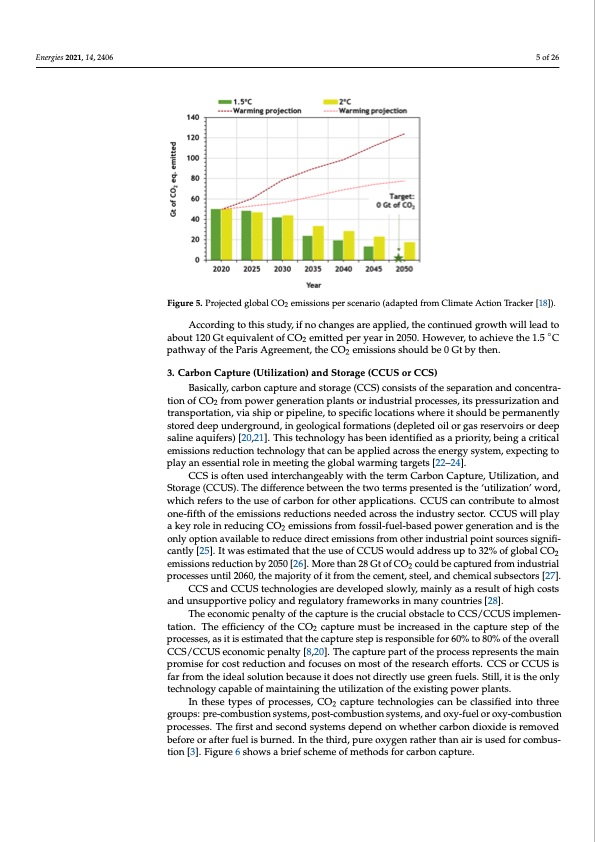
PDF Publication Title:
Text from PDF Page: 005
Energies 2021, 14, 2406 5 of 26 Figure 5. Projected global CO2 emissions per scenario (adapted from Climate Action Tracker [18]). According to this study, if no changes are applied, the continued growth will lead to about 120 Gt equivalent of CO2 emitted per year in 2050. However, to achieve the 1.5 ◦C pathway of the Paris Agreement, the CO2 emissions should be 0 Gt by then. 3. Carbon Capture (Utilization) and Storage (CCUS or CCS) Basically, carbon capture and storage (CCS) consists of the separation and concentra- tion of CO2 from power generation plants or industrial processes, its pressurization and transportation, via ship or pipeline, to specific locations where it should be permanently stored deep underground, in geological formations (depleted oil or gas reservoirs or deep saline aquifers) [20,21]. This technology has been identified as a priority, being a critical emissions reduction technology that can be applied across the energy system, expecting to play an essential role in meeting the global warming targets [22–24]. CCS is often used interchangeably with the term Carbon Capture, Utilization, and Storage (CCUS). The difference between the two terms presented is the ‘utilization’ word, which refers to the use of carbon for other applications. CCUS can contribute to almost one-fifth of the emissions reductions needed across the industry sector. CCUS will play a key role in reducing CO2 emissions from fossil-fuel-based power generation and is the only option available to reduce direct emissions from other industrial point sources signifi- cantly [25]. It was estimated that the use of CCUS would address up to 32% of global CO2 emissions reduction by 2050 [26]. More than 28 Gt of CO2 could be captured from industrial processes until 2060, the majority of it from the cement, steel, and chemical subsectors [27]. CCS and CCUS technologies are developed slowly, mainly as a result of high costs and unsupportive policy and regulatory frameworks in many countries [28]. The economic penalty of the capture is the crucial obstacle to CCS/CCUS implemen- tation. The efficiency of the CO2 capture must be increased in the capture step of the processes, as it is estimated that the capture step is responsible for 60% to 80% of the overall CCS/CCUS economic penalty [8,20]. The capture part of the process represents the main promise for cost reduction and focuses on most of the research efforts. CCS or CCUS is far from the ideal solution because it does not directly use green fuels. Still, it is the only technology capable of maintaining the utilization of the existing power plants. In these types of processes, CO2 capture technologies can be classified into three groups: pre-combustion systems, post-combustion systems, and oxy-fuel or oxy-combustion processes. The first and second systems depend on whether carbon dioxide is removed before or after fuel is burned. In the third, pure oxygen rather than air is used for combus- tion [3]. Figure 6 shows a brief scheme of methods for carbon capture.PDF Image | Current Developments of Carbon Capture Storage

PDF Search Title:
Current Developments of Carbon Capture StorageOriginal File Name Searched:
energies-14-02406.pdfDIY PDF Search: Google It | Yahoo | Bing
NFT (Non Fungible Token): Buy our tech, design, development or system NFT and become part of our tech NFT network... More Info
IT XR Project Redstone NFT Available for Sale: NFT for high tech turbine design with one part 3D printed counter-rotating energy turbine. Be part of the future with this NFT. Can be bought and sold but only one design NFT exists. Royalties go to the developer (Infinity) to keep enhancing design and applications... More Info
Infinity Turbine IT XR Project Redstone Design: NFT for sale... NFT for high tech turbine design with one part 3D printed counter-rotating energy turbine. Includes all rights to this turbine design, including license for Fluid Handling Block I and II for the turbine assembly and housing. The NFT includes the blueprints (cad/cam), revenue streams, and all future development of the IT XR Project Redstone... More Info
Infinity Turbine ROT Radial Outflow Turbine 24 Design and Worldwide Rights: NFT for sale... NFT for the ROT 24 energy turbine. Be part of the future with this NFT. This design can be bought and sold but only one design NFT exists. You may manufacture the unit, or get the revenues from its sale from Infinity Turbine. Royalties go to the developer (Infinity) to keep enhancing design and applications... More Info
Infinity Supercritical CO2 10 Liter Extractor Design and Worldwide Rights: The Infinity Supercritical 10L CO2 extractor is for botanical oil extraction, which is rich in terpenes and can produce shelf ready full spectrum oil. With over 5 years of development, this industry leader mature extractor machine has been sold since 2015 and is part of many profitable businesses. The process can also be used for electrowinning, e-waste recycling, and lithium battery recycling, gold mining electronic wastes, precious metals. CO2 can also be used in a reverse fuel cell with nafion to make a gas-to-liquids fuel, such as methanol, ethanol and butanol or ethylene. Supercritical CO2 has also been used for treating nafion to make it more effective catalyst. This NFT is for the purchase of worldwide rights which includes the design. More Info
NFT (Non Fungible Token): Buy our tech, design, development or system NFT and become part of our tech NFT network... More Info
Infinity Turbine Products: Special for this month, any plans are $10,000 for complete Cad/Cam blueprints. License is for one build. Try before you buy a production license. May pay by Bitcoin or other Crypto. Products Page... More Info
| CONTACT TEL: 608-238-6001 Email: greg@infinityturbine.com | RSS | AMP |